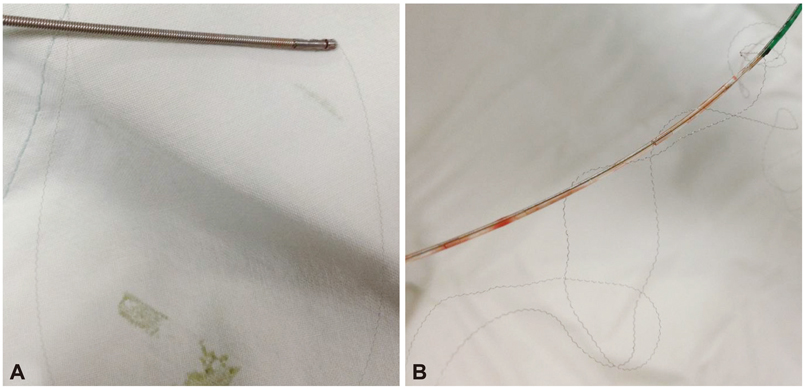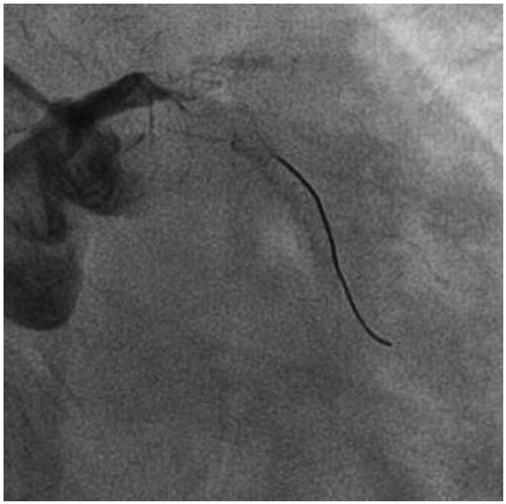Korean Circ J.
2013 Nov;43(11):761-765. 10.4070/kcj.2013.43.11.761.
Fatal Subacute Stent Thrombosis Induced by Guidewire Fracture with Retained Filaments in the Coronary Artery
- Affiliations
-
- 1Division of Cardiology, Department of Internal Medicine, Haeundae Paik Hospital, Inje University College of Medicine, Busan, Korea. jo1216@inje.ac.kr
- KMID: 2224808
- DOI: http://doi.org/10.4070/kcj.2013.43.11.761
Abstract
- During percutaneous coronary intervention, guidewire fractures are very exceptionally encountered in medical practice, but can cause fatal complications such as intracoronary thrombus formation, embolization and perforation. Removal of the remnant segments of guidewire is important for the prognosis. There are several methods being recommended for the treatment of fractured guidewire remnants. However, the best treatment of remnant guidewire filament is still unclear. Herein, we present a case where we did not completely remove remnant guidewire filaments that caused fatal coronary thrombosis.
Keyword
MeSH Terms
Figure
Reference
-
1. Hartzler GO, Rutherford BD, McConahay DR. Retained percutaneous transluminal coronary angioplasty equipment components and their management. Am J Cardiol. 1987; 60:1260–1264.2. Khonsari S, Livermore J, Mahrer P, Magnusson P. Fracture and dislodgment of floppy guidewire during percutaneous transluminal coronary angioplasty. Am J Cardiol. 1986; 58:855–856.3. Woodfield SL, Lopez A, Heuser RR. Fracture of coronary guidewire during rotational atherectomy with coronary perforation and tamponade. Cathet Cardiovasc Diagn. 1998; 44:220–223.4. Al-Amri HS, AL-Moghairi AM, Calafiore AM. Left main approach for retrieval of retained guidewire fragment. J Card Surg. 2012; 27:307–308.5. van Gaal WJ, Porto I, Banning AP. Guide wire fracture with retained filament in the LAD and aorta. Int J Cardiol. 2006; 112:e9–e11.6. Hong YM, Lee SR. A case of guide wire fracture with remnant filaments in the left anterior descending coronary artery and aorta. Korean Circ J. 2010; 40:475–477.7. Alexiou K, Kappert U, Knaut M, Matschke K, Tugtekin SM. Entrapped coronary catheter remnants and stents: must they be surgically removed? Tex Heart Inst J. 2006; 33:139–142.8. Kim JH, Kim GH, Moon KW. Successful transradial retrieval of broken catheter fragment during transradial coronary angiography. J Invasive Cardiol. 2012; 24:74–75.9. Karabulut A, Daglar E, Cakmak M. Entrapment of hydrophilic coated coronary guidewire tips: which form of management is best? Cardiol J. 2010; 17:104–108.10. Collins N, Horlick E, Dzavik V. Triple wire technique for removal of fractured angioplasty guidewire. J Invasive Cardiol. 2007; 19:E230–E234.11. Cho YH, Park S, Kim JS, et al. Rescuing an entrapped guidewire using a Tornus catheter. Circ J. 2007; 71:1326–1327.12. Kim JY, Yoon J, Jung HS, et al. Broken guidewire fragment in the radio-brachial artery during transradial sheath placement: percutaneous retrieval via femoral approach. Yonsei Med J. 2005; 46:166–168.13. Kang JH, Rha SW, Lee DI, et al. Successful retrieval of a fractured and entrapped 0.035-inch terumo wire in the femoral artery using biopsy forceps. Korean Circ J. 2012; 42:201–204.14. Darwazah AK, Abu Sham'a RA, Yassin IH, Islim I. Surgical intervention to remove an entrapped fractured guidewire during angioplasty. J Card Surg. 2007; 22:526–528.
- Full Text Links
- Actions
-
Cited
- CITED
-
- Close
- Share
- Similar articles
-
- Subacute In-stent Thrombosis after Carotid Artery Stenting: A Case Report
- Acute Coronary Stent Thrombosis in Cancer Patients: A Case Series Report
- Surgical Retrieval of Fractured Percutaneous Coronary Intervention Guidewire
- Risk of Stent Stenosis after Implanting a First-Generation Drug-Eluting Stent and Drug Balloon Angioplasty
- Retained Sleeve Marker Ring of a Stent Delivery System in the Coronary Artery Following Coronary Artery Stenting






